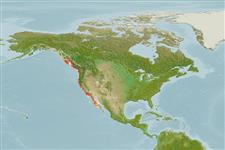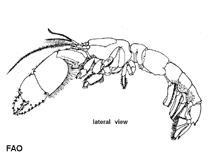Neotrypaea californiensis (Dana, 1854)
Bay ghost shrimp| Native range | All suitable habitat | Point map | Year 2050 |

|
| This map was computer-generated and has not yet been reviewed. |
| Neotrypaea californiensis AquaMaps Data sources: GBIF OBIS |
Classification / Names Common names | Synonyms | CoL | ITIS | WoRMS
| Decapoda | Callianassidae
Environment: milieu / climate zone / depth range / distribution range Écologie
; saumâtre; profondeur 0 - 110 m (Ref. 101444). Temperate; 60°N - 26°N, 138°W - 112°W (Ref. 4)
Distribution Pays | Zones FAO | Écosystèmes | Occurrences | Introductions
Eastern Pacific: from southeast Alaska, USA to San Quintin Bay, Baja California, Mexico and El Coyote Estuary, Point Abreojos Baja California Sur, Mexico. Tropical to temperate.
Length at first maturity / Taille / Poids / Âge
Maturity: Lm ?, range 1 - 1 cm Max length : 11.5 cm TL mâle / non sexé; (Ref. 4)
Description synthétique Morphologie
Rostrum hardly noticeable, a slight angle in the anterior margin of the carapace. Eyes triangular reaching with their full length beyond the rostrum. Antennal angles rounded, without spine. Antennal peduncle somewhat shorter than antennular. Third maxilliped with merus and ischium strongly widened to an operculum; last three segments far narrower, each about twice as long as wide. Large chela of adult male with a distinct concavity the anterior margin of the palm above the base of the fixed finger; this concavity absent or inconspicuous in female and juvenile males. Carpus about as long as the palm, and about as high as long. Merus with a distinct broad and bluntly truncated process in the basal part of the lower margin; in the female this process is more in the shape of triangular tooth. Telson about quadrangular, longer than wide and slightly and gradually narrowing posteriorly; the posterolateral angles are broadly rounded; the posterior margin shows a small triangular tooth in the middle; other teeth or spines are present. Endopod of uropod squarish with rounded angles, slightly longer than the telson (Ref. 4).
Assumed total body length is 11.5 cm (Ref. 4). Found in tidal flats of sand and mud on the sea coasts and in estuarine areas. Forms burrows in soft substrates (Ref. 4). Primarily feeds on plankton and sediment detritus obtained from burrowing. Regularly burrows to find food, re-tunneling up to a depth of 76 cm (Ref. 101553).
Life cycle and mating behavior Maturité | Reproduction | Frai | Œufs | Fécondité | Larves
Mating behavior: Precopulatory courtship ritual is common (through olfactory and tactile cues); usually indirect sperm transfer (Ref. 833).
Référence principale
Références | Coordinateur | Collaborateurs
Holthuis, L.B. 1991. (Ref. 4)
Statut dans la liste rouge de l'IUCN (Ref. 130435)
statut CITES (Ref. 108899)
Not Evaluated
CMS (Ref. 116361)
Not Evaluated
Menace pour l'homme
Utilisations par l'homme
Pêcheries: commercial; appât: usually
| FishSource |
Outils
Plus d'informations
Pays
Zones FAO
Écosystèmes
Occurrences
Introductions
Stocks
Écologie
Régime alimentaire
Éléments du régime alimentaire
Zones FAO
Écosystèmes
Occurrences
Introductions
Stocks
Écologie
Régime alimentaire
Éléments du régime alimentaire
Sources Internet
BHL | BOLD Systems | CISTI | DiscoverLife | FAO(Publication : search) | Fishipedia | GenBank (genome, nucleotide) | GloBI | Gomexsi | Google Books | Google Scholar | Google | PubMed | Arbre de Vie | Wikipedia (Go, chercher) | Zoological Record
Estimates based on models
Preferred temperature
(Ref. 115969): 8.7 - 12.8, mean 10.3 (based on 62 cells).
Catégorie de prix
(Ref. 80766):
Unknown.



